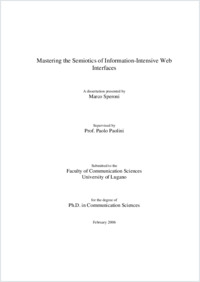Mastering the semiotics of information-intensive web interfaces
- Speroni, Marco
- Paolini, Paolo (Degree supervisor)
-
30.05.2006
200 p
Thèse de doctorat: Università della Svizzera italiana, 2006 (jury note: Magna cum laude)
English
Communication is virtually impossible when interlocutors lack the ability to negotiate meanings. The intended semantics of the language used by a sender should be perceived and mastered by its receiver/s. For this reason the sender should always vision and identify himself in the receiver in order to design the most clear and proper signs with respect to her/his knowledge. Web sites are complex interactive communication tools. In order to let users manage and control their content and services, they make use of different languages, different families of signs involving different sets of knowledge that the user should be somehow familiar with. Web designers (senders) should design interface signs so that their intended meaning could be correctly interpreted by the envisioned users (receivers). This work presents a novel approach for analyzing the different kinds of signs composing web interfaces and better understanding their relationship with the process of user’s understanding. Starting from Linguistic/Semiotic theories and key achievements in Hypermedia Interface Design, this research developed a semiotic framework (W-SIDE Framework) for analyzing and evaluating the user’s understanding of the interface language of web applications. W-SIDE Framework comprises a conceptual toolkit (W-SIDE Model) and an evaluation technique (W-SIDE Evaluation Technique) for modeling and evaluating the clarity of web interface language with respect to critic user profiles. W-SIDE represents a useful conceptual tool supporting web interface design and evaluation, by making experts aware of potential user misunderstandings caused by a gap between the knowledge presupposed by web signs and the one owned by targeted users. The empirical validation of the framework has been carried out in two ways. Firstly, the method has been employed in web projects on the field. The results obtained from analyzing and evaluating web applications through W-SIDE have been compared with the ones obtained from observing real users while interacting with the same applications, in order to check the reliability of the method. Secondly, the framework has been constantly reviewed by experts from both the linguistic/semiotic and the web design field: the feedback gathered is encouraging for further improvements.
- Language
-
- English
- Classification
- Computer science and technology
- License
-
License undefined
- Identifiers
-
- RERO DOC 5891
- URN urn:nbn:ch:rero-006-108458
- ARK ark:/12658/srd1317970
- Persistent URL
- https://n2t.net/ark:/12658/srd1317970
Statistics
Document views: 498
File downloads:
- Texte intégral: 390
